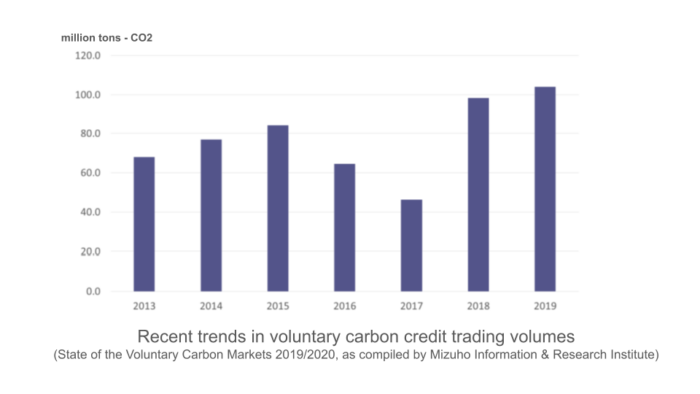What are Voluntary Carbon Credits? A Comprehensive Guide to Meaning, Benefits, and Types
As companies accelerate their efforts toward decarbonization, voluntary carbon credits, a type of environmental certificate and credit, are attracting significant attention. Voluntary carbon credits are primarily issued by international companies and organizations, but what are the benefits of introducing them? This article explains the overview, purchasing methods, and specific applications of the main voluntary carbon credits traded worldwide.

目次
What are Voluntary Carbon Credits?
Voluntary carbon credits are a mechanism for buying and selling greenhouse gas (GHG) emission reductions, including CO2, to achieve carbon offsetting. These credits have been pioneered by private companies and organizations overseas, with a sharp increase in trading volume between 2017 and 2018, indicating their growing prominence. They are expected to become more widespread in Japan in the future.

Note: translated by Shizen Energy based on source from the Mizuho Information & Research Institute
Source: 今、注目を集める、ボランタリー・クレジット~4 つのメガトレンドと、今後の行方を解説~(みずほ情報総研) (Japanese)
The Context Behind the Rise of Voluntary Carbon Credits
In 2020, Japan declared that it aims to achieve carbon neutrality by 2050. The goal is to achieve net-zero CO2 emissions by 2050, and one of the key initiatives is reducing greenhouse gas emissions in the industrial sector. This has led to the development and implementation of policies aimed at decarbonizing the energy sector (which accounts for over 80% of GHG emissions), promoting renewable energy, and establishing CO2 capture technologies. Against this backdrop, private companies are also being called upon to take action toward decarbonization, making voluntary carbon credits, which can contribute to reducing GHG emissions, a focal point of interest.
The Difference Between Voluntary Carbon Credits and Japanese Environmental Certificates
Voluntary carbon credits are issued by private companies and NGOs, with a wide variety of credits traded globally. The key difference between voluntary carbon credits and Japan’s main environmental certificates (J-Credits, Green Electricity Certificates, and Non-Fossil Fuel Certificates) is that the latter are led by the government or local municipalities.
Japanese environmental certificates can be officially declared as part of a company’s CO2 reduction for public reporting related to laws like the Act on Promotion of Global Warming Countermeasures and the Act on Rational Use of Energy, and for international initiatives such as RE100, CDP, and SBT. In contrast, voluntary carbon credits are considered a carbon offset activity that private sector entities voluntarily undertake and cannot be used for official public reporting.
Benefits of Implementing Voluntary Carbon Credits
There are two main benefits to implementing voluntary carbon credits:
- They offer flexibility because they are not a national or regional system.
- They can offset difficult-to-reduce GHG emissions.
Broad Applicability Beyond National and Regional Regulatory Requirements
Since voluntary carbon credits are based on companies’ voluntary efforts, they are subject to fewer administrative laws and regulations, allowing for a wide range of applications. Compared to government-led certificates, they also have the added benefit of generating effects beyond just CO2 emission reductions. For example, a growing number of companies are using voluntary carbon credits to contribute to marine and river water quality conservation, biodiversity preservation, and job creation through the credit issuance process.
For instance, Tokyo Gas is supporting seagrass bed restoration activities in Tokyo Bay. Seagrass is a plant that contributes to stabilizing water quality and biodiversity. Additionally, the presence of CO2-absorbing plants like seagrass is a type of Blue Carbon and is expected to help prevent global warming. Tokyo Gas purchased J-Blue Credits generated from the Yokohama seagrass bed to offset a portion of the CO2 emissions from gas consumption at its Yokohama showroom.
Offsetting Difficult-to-Reduce GHG Emissions
Voluntary carbon credits should be used as a means of carbon offsetting, not as a primary method of fundamental CO2 reduction. Therefore, it is essential for companies to have concrete decarbonization initiatives in place before using voluntary carbon credits. Companies should execute their own decarbonization plans, gradually reducing their CO2 emissions, and only use voluntary carbon credits to compensate for GHG emissions that are difficult to reduce through business activities alone.

Main Types of voluntary carbon credits
There is a wide variety of voluntary carbon credits available, but here are four of the main types traded worldwide:
VCS (Verified Carbon Standard)
The VCS was established in 2005 by organizations such as the World Business Council for Sustainable Development (WBCSD) and the International Emissions Trading Association (IETA) to create a standard for ensuring the quality of credits generated from GHG emission reduction and absorption projects. It is the most widely used voluntary carbon credit globally, and its high reliability has led to its adoption by a broad range of companies.
GS(Gold Standard)
The GS is a certification standard and system established in 2003 by international environmental NGOs like the World Wide Fund for Nature (WWF). It guarantees the quality of voluntary carbon credits to contribute to GHG reduction and sustainable development. In addition to issuing voluntary carbon credits, GS also has the role of screening and certifying projects that make a high contribution to preventing global warming.
ACR(American Carbon Registry)
The ACR is the world’s first private credit certification standard and system, established in 1996 by the American non-profit Winrock International. As a pioneer in using market forces to improve the environment and accelerate GHG reduction activities, it disseminates information and sets standards for carbon offset quality to enhance the credibility of voluntary carbon credits.
CAR(Climate Action Reserve)
The CAR is a certification standard and system founded in 2001 by a California-based organization. It issues transparent voluntary carbon credits and uses a publicly accessible system to ensure fair trading. Its unique offset program promotes GHG reduction through voluntary carbon credits, supporting both environmental protection and the growth of green technologies.
How to Utilize Voluntary Carbon Credits
Here are two ways to effectively utilize voluntary carbon credits in your business activities after purchasing them:
Voluntary Reduction of CO2 Emissions in Business Activities
In Japan, the application of voluntary carbon credits for public bodies and public reporting is still limited. However, they are highly effective as a means for companies to voluntarily work toward carbon neutrality in their business activities. By highlighting the use of voluntary carbon credits to stakeholders such as financial institutions, shareholders, and investors, companies can potentially enhance their corporate value. Furthermore, announcing these environmental initiatives to business partners can lead to the implementation of concrete measures for reducing CO2 emissions across the entire supply chain in the future.
Promoting Your Company’s Climate Change Measures
By using voluntary carbon credits, a company can offset the CO2 emissions from its events or add value to its products by making them carbon-neutral. By adopting carbon credits that are regionally related to its business, a company can also contribute to the revitalization of local industries and educational activities. This allows the company to publicly promote itself as a leader in decarbonization management, which can attract environmentally conscious customers and lead to improved brand image and trust.

How to Purchase Voluntary Carbon Credits
There are two ways to purchase voluntary carbon credits for your company. If you want to use voluntary carbon credits, consider which method is right for your organization.
Direct Purchase from Other Companies
One method is to purchase credits directly from private companies or organizations that handle them. However, with a vast number of voluntary carbon credits being issued in the U.S. and Europe, it can be challenging to find the right ones for your specific needs.
Purchase Through an Exchange
Another method is to purchase credits through a company that specializes in trading environmental certificates. If you are unsure which credits are reliable or want to find a credit suitable for your industry, consulting with a professional at an exchange is the most efficient approach.
At Shizen Energy Inc., with particular expertise in procurement within Japan, we offer services that support the purchase of voluntary carbon credits, such as “J Blue Credits,” as well as other environmental certificates like J-Credits and Non-Fossil Fuel Certificates. If you want to accelerate your company’s decarbonization efforts or learn more about the types and implementation methods of environmental certificates, please refer to the page below.
Summary
Voluntary carbon credits are a type of carbon credit issued by private companies and NGOs worldwide. They are a mechanism for trading CO2 emission reductions. Unlike environmental certificates led by the Japanese government, voluntary carbon credits are not subject to government regulations, allowing for flexible use. However, it’s important to note that they cannot be included in official reports as a means of public CO2 emission reduction.
By carefully considering the overview, benefits, types, purchasing methods, and applications of voluntary carbon credits discussed in this article, you can begin to make choices that will help your company achieve its carbon neutrality goals.
| 【reference】 All reference materials are in Japanese. ・ 2050 年カーボンニュートラルに伴うグリーン成長戦略(内閣官房など) ・日本貿易振興機構(JETRO)公式サイト ・今、注目を集める、ボランタリー・クレジット~4つのメガトレンドと、今後の行方を解説~(みずほ情報総研) ・今日は「世界海洋デー」◆注目のブルーカーボン・クレジット(東京ガス株式会社) ・カーボン・クレジット・レポートの概要(経済産業省) ・American Carbon Registry 公式ホームページ ・Climate Action Reserve 公式ホームページ ・ジャパンブルーエコノミー技術研究組合 |





